New Invasive Pest #1: Box Tree Moth
What we feared has once again occurred—a new invasive pest we've been watching for has finally been detected in the United States. This time, my home state of South Carolina is on top of the list of affected states. Click HERE for the USDA’s press release.
Last week, USDA APHIS confirmed the detection of box tree moth in several facilities in the United States. Between August 2020 and April 2021, boxwoods that had been infested with box tree moths were shipped from a nursery in St. Catherines, Ontario, Canada, to 25 retail facilities in Connecticut, Massachusetts, Michigan, New York, Ohio and South Carolina, and one distribution center in Tennessee.
Among these facilities, box tree moths were detected in three facilities in Michigan, one in Connecticut and one in South Carolina. At this time, it isn’t known if the pest has established in the landscape through planting of infested plants.
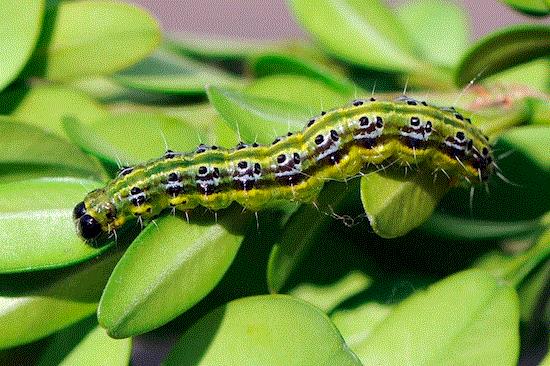
Box tree moth caterpillar. (Photo credit: Friedrich Boehringer, Wikipedia.)
USDA APHIS halted all importation of boxwood, euonymus and holly from Canada. APHIS is also working with the regulatory agencies of the affected states on determining the extent of introduction, destroying the plants and tracing potentially infested plants that'd been sold.
Although infestation hasn't been detected in the landscape—i.e. the pest hasn't been established—this introduction is quite significant for our industry. It may result in some regulatory actions down the road.
To prepare everyone in dealing with this pest, the staff at the Southern IPM Center is working with several scientists and regulators at USDA, Georgia and South Carolina to produce education materials. These include a fact sheet on the pest, a fact sheet on distinguishing box tree moth from other moth species that look like it, and a PowerPoint presentation for use in extension education. I’ll also work with my colleagues to prepare a short summary on the pest’s biology, identification and management. The resources will become available in a few days and I’ll direct y’all to them once they're ready.
We've been watching this pest for some time because we know this pest will be a significant threat to our industry. GrowerTalks was one of the first publications to feature the pest in the April 2019 issue. Mike Skvarla of Pennsylvania State University also has a wonderful fact sheet about this pest online.
The Invasive Species Centre has scheduled a webinar, "Box Tree Moth 101," for June 10 at 11:00 a.m. Eastern/10:00 a.m. Central. Register HERE for the webinar.
If you receive or bought boxwood recently, keep an eye on them. If you see any caterpillars or damage that looks like the box tree moth, please contact your local extension service or regulatory agencies immediately.

New Invasive Pest #2: Elm Zigzag Sawfly
Tree Dellinger of Virginia Tech shared the news of another newly detected invasive pest last Friday.
Specialists at the USDA-ARS Systematic Entomology Lab confirmed that some sawfly larvae collected in Winchester, Virginia, in May 2021, belong to a species previously unknown in the United States. This is elm zigzag sawfly, Aproceros leucopoda.
Why is it called the elm zigzag sawfly? Well, have a look at the characteristic damage pattern in the picture below:

Zig-zag damage on an elm leaf. (Photo credit: Heather Huntington, Virginia Department of Agriculture and Consumer Services.)
The collection of larvae in Virginia was taken from Chinese elm, but elm zigzag sawfly is also known to feed on American elm, English elm, Siberia elm and several other elm species. (Hence, the other part of its common name.)
A female sawfly, which is actually a wasp, deposits eggs on the leaf margin. The larvae begin to feed on the leaf after hatching, making progressively larger zig-zag damage as they grow. Mature larvae can consume the entire leaf. Combining a voracious appetite, fast development (thus multiple generations per year) and the ability to reproduce without mating, you get a species that can spread fast and cause severe defoliation. Although the elm zigzag sawfly can cause significant defoliation, the long-term damage of feeding to tree health isn't completely clear.
The detection of elm zigzag sawfly represents the first record in the United States, but the second in North America. The first North American detection was made in Sainte-Martine, Quebec, Canada, in 2020. East Asia is the homeland of this species. It's been spread through Europe since 2003. It isn’t clear from where or how this species was introduced to the United States at this time.
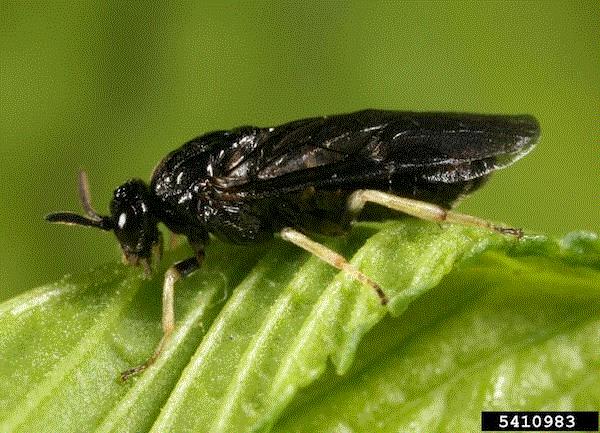
An adult elm zigzag sawfly. (Photo credit: Gyorgy Csoka, Hungury Forest Research Institute; insectimages.org.)
Adults look like black, elongated flies with pale-colored legs. Not particularly distinguishable from many other wasp and fly species, in my opinion. The larvae are also undistinguished. They're greenish or pale colored. The larvae pupate inside lacey coccons spun underneath the leaves.
Do not confuse the larvae of the elm zigzag sawfly from the more common elm sawfly larvae. Elm sawfly larvae don't cause the zig-zag damage and they're yellowish white with a black stripe down the back and black spots along the sides of the body.
Sawfly larvae look like caterpillars, but they're actually larvae of wasps. If you look closely, you’ll find prolegs (stubby, fleshy legs) on every abdominal segment of a sawfly larva. On caterpillars, however, you’ll find prolegs on some abdominal segments. A caterpillar look-alike with four or fewer pairs of prolegs is a moth or butterfly larva. If there are more than four pairs (up to seven pairs), then you're looking at a sawfly larva.
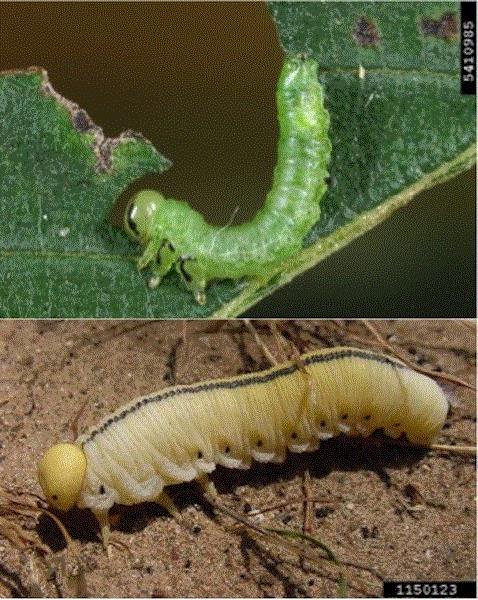
An elm zigzag sawfly larva (top; Photo credit: Gyorgy Csoka, Hungary Forest Research Institute; insectimages.org), and a elm sawfly larva (bottom; Photo credit: Joe Pase, Texas A&M Forest Service).
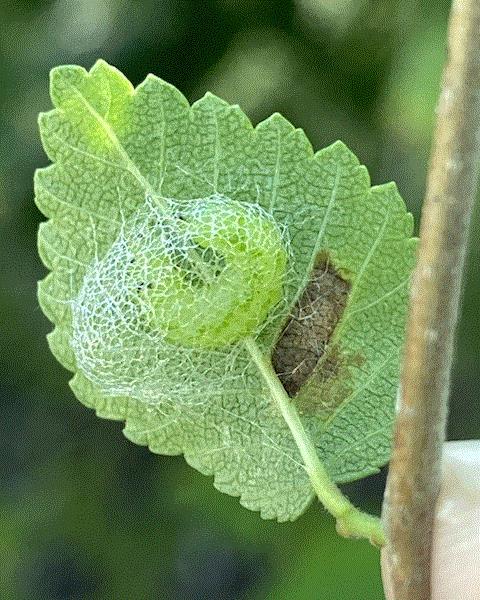
A mature larva is ready to pupate in its coccoon. (Photo credit: Heather Huntington, Virginia Department of Agriculture and Consumer Services.)
Distinguishing whether it’s sawfly larva or caterpillar is important because some biological control tools, particularly biopesticides, don’t work equally well against them. For example, Bt works great against caterpillars, but not against sawfly larvae.
We don't know the extent of the spread of elm zigzag sawfly. Keep an eye on your elm trees this summer. If y’all find any zigzag defoliation pattern on the elm trees, inform your local extension agent, or federal or state plant industry or regulatory agency personnel.
More info and pictures of the elm zigzag sawfly can be found on the websites of the Centre for Agriculture and Bioscience International (CABI) and the Canadian Food Inspection Agency.

BASF Introduces Avelyo
Avelyo is a new broad-spectrum fungicide containing mefentrifluconazole. Mefentrifluconazole is a brand new DMI fungicide (FRAC Group 3) for the greenhouse and nursery market.
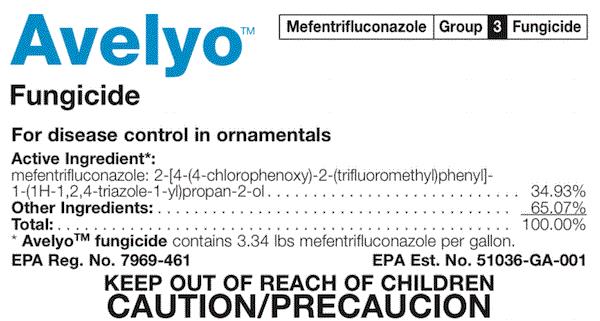
Avelyo is registered for use against multiple fungal diseases in greenhouses, interiorscapes, nurseries and Christmas tree farms. This product is not registered for use on residential ornamentals. Avelyo has long residual activity and outstanding rainfastness, according to BASF.
Avelyo can be applied as a foliar spray to preventively control antharacnose, leaf spots, stem blights, powdery mildew, scabs and rusts on ornamental plants. Spray application rate ranges are from 8 to 10 fl. oz. per 100 gal. for rusts and 3 to 5 fl. oz. per 100 gal. for other diseases. Avelyo can also be drenched at 2 to 3 fl. oz. per 100 gal. against root and crown diseases, such as cylindrocladium and black root rot.
Ann Chase conducted a trial comparing the efficacy of Avelyo with several fungicides in controlling Fusarium wilt of cyclamen. The most effective fungicides at the end of the trial were Orkestra Intrinsic (10 fl. oz. per 100 gal.) and Postiva (14 and 21 fl. oz. per 100 gal.), and to a lesser degree Avelyo (3 fl. oz. per 100 gal.). Avelyo and Orkestra Intrinsic (fluxapyroxad + pyraclostrobin; FRAC 7 + 11) were applied as a drench twice 14 days apart and Postiva was applied as a drench once. Postiva is a combination product (pydiflumetofen + difenoconazole; FRAC 7 + 3) not yet available in the market.
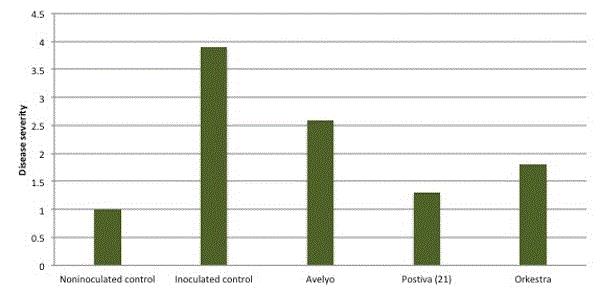
Efficacy of Avelyo against Fusarium wilt on cyclamen. Disease severity was rated on a scale of 1 to 5, with 1 being no disease and 5 being a dead plant. (Data source: IR-4 Environmental Horticulture Program. Researcher: Ann Chase.)
In another study supported by IR-4 Environmental Horticulture Program, Fulya Baysal-Gurel of Tennessee State University evaluated the efficacy of several fungicides against Fusarium root and crown rots on oakleaf hydrangea. Fulya found that drenches of Avelyo (3 fl. oz. per 100 gal.) and Postiva (14 and 21 fl. oz. per 100 gal.), and sprenches of Astun (13.5 and 17 fl. oz. per 100 gal.; isofetamid, FRAC 7), Terraguard (8 oz. per 100 gal.; triflumizole, FRAC 3), KleenGlow (3.35 fl. oz. per gal.; didecyldimethylam monium chloride), and Empress Intrinsic (3 fl. oz. per 100 gal.; pyraclostrobin, FRAC 11) were effective in suppressing Fusarium crown rot.
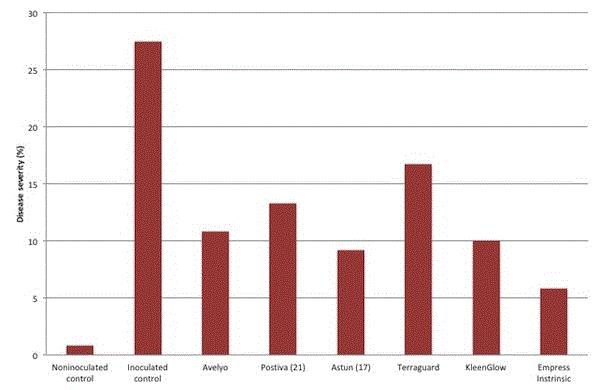
Efficacy of fungicides against Fusarium crown rot on oakleaf hydrangea. Disease severity was rated in percentage of diseased tissues. (Data source: IR-4 Environmental Horticulture Program. Researcher: Fulya Baysal-Gurel.)
Click HERE to access efficacy data on the IR-4 Environmental Horticulture Program database.
The signal word for Avelyo is “Caution.” Required personal protective equipment (PPE) include long-sleeved shirt, long pants, and chemical-resistant gloves, shoes and socks. The restricted entry interval (REI) is 12 hours.
Click HERE for more information on Avelyo.






See y'all later!

JC Chong
Professor of Entomology at Clemson University
This e-mail received by 26,607 subscribers like you!
If you're interested in advertising on PestTalks contact Kim Brown ASAP!